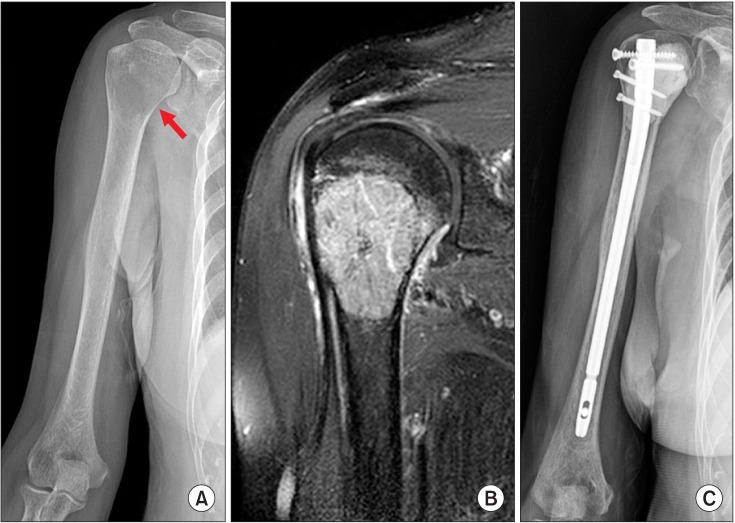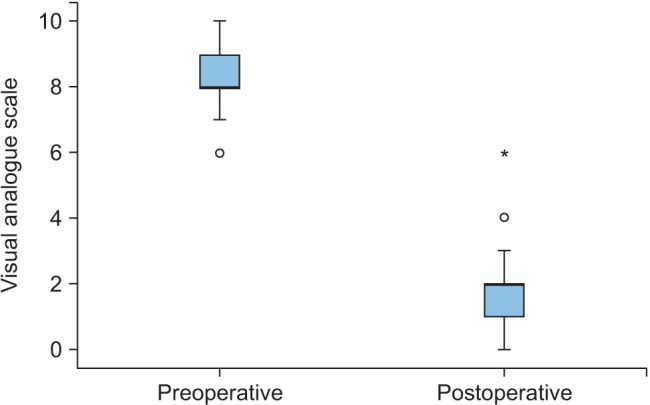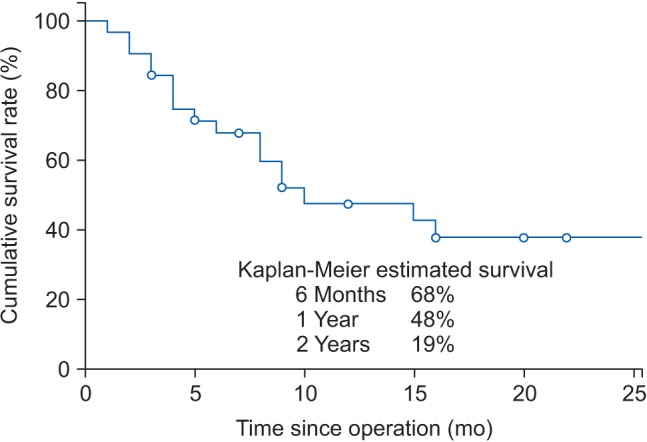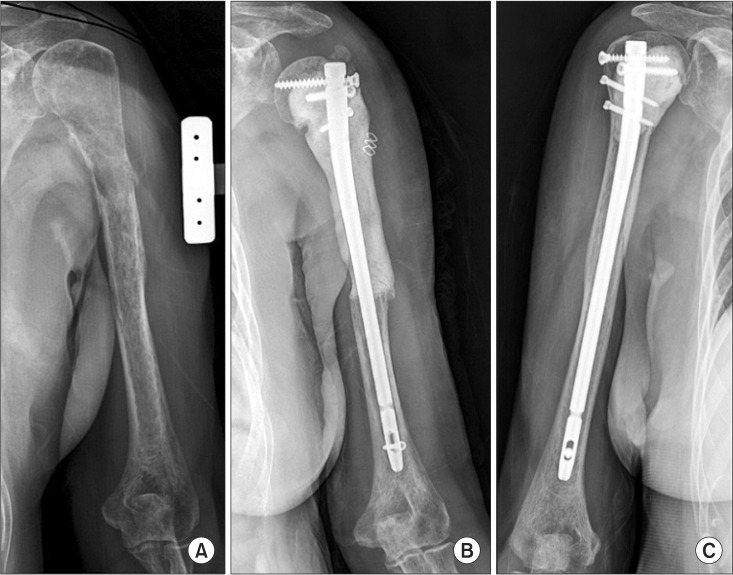Clin Orthop Surg.
2016 Dec;8(4):458-464. 10.4055/cios.2016.8.4.458.
Intramedullary Nailing for Pathological Fractures of the Proximal Humerus
- Affiliations
-
- 1Department of Orthopedic Surgery, Seoul National University Hospital, Seoul, Korea. hankim@snu.ac.kr
- 2Department of Orthopedic Surgery, Seoul National University Bundang Hospital, Seongnam, Korea.
- KMID: 2412330
- DOI: http://doi.org/10.4055/cios.2016.8.4.458
Abstract
- BACKGROUND
Endoprosthetic reconstruction is widely applied for pathological fractures of the proximal humerus; however, functional impairment is usually unsatisfactory. The aims of the current study are to evaluate the reliability of interlocking intramedullary (IM) nailing with cement augmentation as a fixation method in proximal humeral lesions and to assess functional outcomes.
METHODS
We reviewed 32 patients with pathological fractures of the proximal humerus who underwent interlocking IM nailing and cement augmentation. Functional scores and pain relief were assessed as outcomes.
RESULTS
The mean follow-up period was 14.2 months. The mean Musculoskeletal Tumor Society functional score and Karnofsky performance status scale score were 27.7 and 75.6, respectively. Improvement of pain assessed using the visual analogue scale was 6.2 on average. Thirty-one patients (97%) experienced no pain after surgery. The mean ranges of forward flexion and abduction were 115° and 112.6°, respectively. All patients achieved stability and had no local recurrence without failure of fixation until the last follow-up.
CONCLUSIONS
Proximal interlocking IM nailing with cement augmentation appears to be a reliable treatment option for pathological or impending fractures of the proximal humerus in selected patients with metastatic tumors, even with extensive bone destruction.
MeSH Terms
Figure
Reference
-
1. Frassica FJ, Frassica DA. Evaluation and treatment of metastases to the humerus. Clin Orthop Relat Res. 2003; (415 Suppl):S212–S218. PMID: 14600613.
Article2. Kim JH, Kang HG, Kim JR, Lin PP, Kim HS. Minimally invasive surgery of humeral metastasis using flexible nails and cement in high-risk patients with advanced cancer. Surg Oncol. 2011; 20(1):e32–e37. PMID: 20870403.
Article3. Weiss KR, Bhumbra R, Biau DJ, et al. Fixation of pathological humeral fractures by the cemented plate technique. J Bone Joint Surg Br. 2011; 93(8):1093–1097. PMID: 21768635.
Article4. Laitinen M, Nieminen J, Pakarinen TK. Treatment of pathological humerus shaft fractures with intramedullary nails with or without cement fixation. Arch Orthop Trauma Surg. 2011; 131(4):503–508. PMID: 20740287.
Article5. Camnasio F, Scotti C, Peretti GM, Fontana F, Fraschini G. Prosthetic joint replacement for long bone metastases: analysis of 154 cases. Arch Orthop Trauma Surg. 2008; 128(8):787–793. PMID: 17922282.
Article6. Thai DM, Kitagawa Y, Choong PF. Outcome of surgical management of bony metastases to the humerus and shoulder girdle: a retrospective analysis of 93 patients. Int Semin Surg Oncol. 2006; 3:5. PMID: 16509975.7. Siegel HJ, Lopez-Ben R, Mann JP, Ponce BA. Pathological fractures of the proximal humerus treated with a proximal humeral locking plate and bone cement. J Bone Joint Surg Br. 2010; 92(5):707–712. PMID: 20436010.
Article8. Capanna R, Campanacci DA. The treatment of metastases in the appendicular skeleton. J Bone Joint Surg Br. 2001; 83(4):471–481. PMID: 11380113.
Article9. Sarahrudi K, Wolf H, Funovics P, Pajenda G, Hausmann JT, Vecsei V. Surgical treatment of pathological fractures of the shaft of the humerus. J Trauma. 2009; 66(3):789–794. PMID: 19276754.
Article10. Atesok K, Liebergall M, Sucher E, Temper M, Mosheiff R, Peyser A. Treatment of pathological humeral shaft fractures with unreamed humeral nail. Ann Surg Oncol. 2007; 14(4):1493–1498. PMID: 17211731.
Article11. Dijkstra S, Stapert J, Boxma H, Wiggers T. Treatment of pathological fractures of the humeral shaft due to bone metastases: a comparison of intramedullary locking nail and plate osteosynthesis with adjunctive bone cement. Eur J Surg Oncol. 1996; 22(6):621–626. PMID: 9005151.
Article12. Karataglis D, Stavridis SI, Petsatodis G, Papadopoulos P, Christodoulou A. New trends in fixation of proximal humeral fractures: a review. Injury. 2011; 42(4):330–338. PMID: 21093859.
Article13. Sosef N, van Leerdam R, Ott P, Meylaerts S, Rhemrev S. Minimal invasive fixation of proximal humeral fractures with an intramedullary nail: good results in elderly patients. Arch Orthop Trauma Surg. 2010; 130(5):605–611. PMID: 20024568.
Article14. Enneking WF, Dunham W, Gebhardt MC, Malawar M, Pritchard DJ. A system for the functional evaluation of reconstructive procedures after surgical treatment of tumors of the musculoskeletal system. Clin Orthop Relat Res. 1993; (286):241–246. PMID: 8425352.
Article15. Young AA, Hughes JS. Locked intramedullary nailing for treatment of displaced proximal humerus fractures. Orthop Clin North Am. 2008; 39(4):417–428. PMID: 18803972.
Article16. Blum J, Hansen M, Rommens PM. Angle-stable intramedullary nailing of proximal humerus fractures with the PHN (proximal humeral nail). Oper Orthop Traumatol. 2009; 21(3):296–311. PMID: 19779685.17. Bickels J, Kollender Y, Wittig JC, Meller I, Malawer MM. Function after resection of humeral metastases: analysis of 59 consecutive patients. Clin Orthop Relat Res. 2005; (437):201–208.
- Full Text Links
- Actions
-
Cited
- CITED
-
- Close
- Share
- Similar articles
-
- Intramedullary Nailing for Complex Fractures of the Proximal and Midshaft of the Humerus
- Interlocking Intramedullary Nailing of the Proximal Humerus Fracture in Elderly Patients over 65 Years old
- Plain Radiograph Analysis of the Distal Humerus Posterior Bowing That May Affect Interlocking Intramedullary Nailing for Humerus Shaft Fracture
- Seidel Interlocking Intramedullary Nailing for Humerus Fractures
- Interlocking Intramedullary Nailing Versus conventional Kuntscher Intramedullary Nailing for Fracture of the Femoral Shaft





